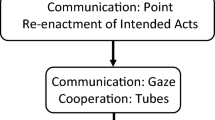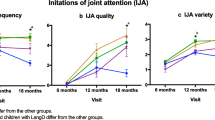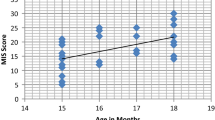Abstract
The extent to which early social communication behaviors predict later communication and intellectual outcomes was investigated via retrospective video analysis. Joint attention, imitation, and complex object play behaviors were coded from edited home videos featuring scenes of 29 children with ASD at 9–12 and/or 15–18 months. A quantitative interval recording of behavior and a qualitative rating of the developmental level were applied. Social communication behaviors increased between 9–12 and 15–18 months. Their mean level during infancy, but not the rate of change, predicted both Vineland Communication scores and intellectual functioning at 3–7 years. The two methods of measurement yielded similar results. Thus, early social communicative behaviors may play pivotal roles in the development of subsequent communication and intellectual functioning.

Similar content being viewed by others
References
Anderson, D. K., Lord, C., Risi, S., DiLavore, P. S., Shulman, C., Thurm, A., et al. (2007). Patterns of growth in verbal abilities among children with autism spectrum disorder. Journal of Counseling and Clinical Psychology, 75, 594–604.
Baghdadli, A., Picot, M.-C., Michelon, C., Bodet, J., Pernon, E., Burstezjn, C., et al. (2007). What happens to children with PDD when they grow up? Prospective follow-up of 219 children from preschool age to mid-childhood. Acta Psychiatrica Scandinavia, 115, 403–412.
Baranek, G. T. (1999). Autism during infancy: A retrospective video analysis of sensory-motor and social behaviors at 9–12 months of age. Journal of Autism and Developmental Disorders, 29, 213–224.
Baranek, G. T., Barnett, C. R., Adams, E. M., Wolcott, N. A., Watson, L. R., & Crais, E. R. (2005). Object play in infants with autism: Methodological issues in retrospective video analysis. American Journal of Occupational Therapy, 59, 20–30.
Barbaro, J., & Dissanayake, C. (2009). Autism spectrum disorders in infancy and toddlerhood: A review of evidence on early signs, early identification tools, and early diagnosis. Journal of Developmental and Behavioral Pediatrics, 30, 447–459.
Baron-Cohen, S., Cox, A., Baird, G., Swettenham, J., Nightingale, N., Morgan, K., et al. (1996). Psychological markers in the detection of autism in infancy in a large population. British Journal of Psychiatry, 168, 158–163.
Bates, E., Camaioni, L., Benigni, L., Bretherton, I., & Volterra, V. (1979). The emergence of symbols: Cognition and communication in infancy. New York: Academic Press.
Bayley, N. (1993). Bayley scales of infant development–II. San Antonio, TX: Psychological Corporation.
Belsky, J., & Most, R. K. (1981). From exploration to play: A cross-sectional study of infant free play behavior. Developmental Psychology, 17, 630–639.
Billstedt, E., Gillberg, I. C., & Gillberg, C. (2007). Autism in adults: symptom patterns and early childhood predictors. Use of the DISCO in a community sample followed from childhood. Journal of Child Psychology and Psychiatry, 48, 1102–1110.
Carpenter, R. L., Mastergeorge, A. M., & Coggins, T. E. (1983). The acquisition of communicative intentions in infants eight to fifteen months of age. Language and Speech, 26, 101–116.
Carpenter, M., Nagell, K., & Tomasello, M. (1998). Social cognition, joint attention, and communicative competence from 9 to 15 months of age. Monographs of the Society for Research in Child Development, 63, 1–143.
Charman, T., Swettenham, J., Baron-Cohen, S., Cox, A., Baird, G., & Drew, A. (1997). Infants with autism: An investigation of empathy, pretend play, joint attention, and imitation. Developmental Psychology, 33, 781–789.
Charman, T., Swettenham, J., Baron-Cohen, S., Cox, A., Baird, G., & Drew, A. (1998). An experimental investigation of social-cognitive abilities in infants with autism: Clinical implications. Infant Mental Health Journal, 19, 260–275.
Charman, T., Baron-Cohen, S., Swettenham, J., Baird, G., Cox, A., & Drew, A. (2000). Testing joint attention, imitation and play as infancy precursors to language and theory of mind. Cognitive Development, 15, 481–498.
Charman, T., Baron-Cohen, S., Swettenham, J., Baird, G., Drew, A., & Cox, A. (2003). Predicting language outcome in infants with autism and pervasive developmental disorder. International Journal of Language and Communication Disorders, 38, 265–285.
Clifford, S. M., & Dissanayake, C. (2008). The early development of joint attention in infants with autistic disorder using home video observations and parental interview. Journal of Autism and Developmental Disorders, 38, 791–805.
Crais, E., Douglas, D. D., & Campbell, C. C. (2004). The intersection of the development of gestures and intentionality. Journal of Speech, Language, and Hearing Research, 47, 678–694.
Dawson, G., Webb, S. J., & McPartland, J. (2005). Understanding the nature of face processing impairment in autism: Insights from behavioral and electrophysiological studies. Developmental Neuropsychology, 27, 403–424.
Dunst, C. J. (1980). A clinical and educational manual for use with the Uzgiris and Hunt scales of infant psychological development. Baltimore, MA: University Park Press.
Ejiri, K., & Masataka, N. (2001). Co-occurrences of preverbal vocal behavior and motor action in early infancy. Developmental Science, 4, 40–48.
Friauf, E., & Lohmann, C. (1999). Development of auditory brainstem circuitry. Activity-dependent and activity-indendent processes. Cell Tissue Research, 297, 187–195.
Howlin, P., Mawhood, L., & Rutter, M. (2000). Autism and developmental receptive language disorder–A follow-up comparison in early adult life. II: Social, behavioral, and psychiatric outcomes. Journal of Child Psychology and Psychiatry, 41, 561–578.
Iverson, J. M. (2010). Developing language in a developing body: The relationship between motor development and language development. Journal of Child Language, 37, 229–261.
Johnson, C. P., Myers, S., & The American Academy of Pediatrics Council on Children with Disabilities. (2007). Identification and evaluation of children with autism spectrum disorders. Pediatrics, 120, 1183–1225.
Kasari, C., Paparella, T., Freeman, S., & Jahromi, L. B. (2008). Language outcome in autism: Randomized comparison of joint attention and play interventions. Journal of Consulting and Clinical Psychology, 76, 125–137.
Laasko, M.-L., Poikkeus, A.-M., Eklund, K., & Lyytinen, P. (1999). Social interactional behaviors and symbolic play competence as predictors of language development and their associations with maternal attention-directing strategies. Infant Behavior and Development, 22, 541–556.
Landa, R. J., Holman, K. C., & Garrett-Mayer, E. (2007). Social and communication development in toddlers with early and later diagnosis of autism spectrum disorders. Archives of General Psychiatry, 64, 853-6-864.
Lewis, V., & Boucher, J. (1988). Spontaneous, instructed and elicited play in relatively able autistic children. British Journal of Developmental Psychology, 6, 325–339.
Lingam, R., Simmons, A., Andrews, N., Miller, E., Stowe, J., & Taylor, B. (2003). Prevalence of autism and parentally reported triggers in a north east London population. Archive of Diseases of Childhood, 88, 666–670.
Lord, C., Rutter, M., DiLavore, P. C., & Risi, S. (1999). Autism diagnostic observation schedule. Los Angeles, CA: Western Psychological Services.
Luyster, R., Qiu, S., Lopez, K., & Lord, C. (2007). Predicting outcomes of children referred for autism using the MacArthur-Bates communicative development inventory. Journal of Speech, Language, and Hearing Research, 50, 667–681.
Luyster, R. J., Kadlec, M. B., Carter, A., & Tager-Flusberg, H. (2008). Language assessment and development in toddlers with autism spectrum disorders. Journal of Autism and Developmental Disorders, 38, 1426–1438.
McEwen, F., Happé, F., Bolton, P., Rijsdijk, F., Ronald, A., Dworzynski, K., et al. (2007). Origins of individual difference in imitation: Links with language, pretend play, and socially insightful behavior in two-year-old twins. Child Development, 78, 474–492.
Meltzoff, A. N. (2007). The “like me” framework for recognizing and becoming an intentional agent. Acta Psychologica, 124, 26–43.
Mullen, E. M. (1995). Mullen scales of early learning. Circle Pines, MN: American Guidance Service, Inc.
Mundy, P., & Hogan, A. (1996). A preliminary manual for the abridged early social communication scales (ESCS). Retrieved Nov 9 2003 from http://www.psy.miami.edu/faculty/pmundy/ESCS.pdf.
Mundy, P., Sigman, M., & Kasari, C. (1990). A longitudinal study of joint attention and language development in autistic children. Journal of Autism and Developmental Disorders, 20, 115–128.
Mundy, P., Sigman, M., & Kasari, C. (1994). Joint attention, developmental level, and symptom presentation in young children with autism. Development and Psychopathology, 6, 389–401.
Mundy, P., Block, J., Delgado, C., Pomares, Y., van Hecke, A. V., & Parlade, M. V. (2007). Individual differences and the development of joint attention in infancy. Child Development, 78, 938–954.
National Research Council. (2001). Educating children with autism. Committee on Educational Interventions for Children with Autism. In C. Lord & J. P. McGee (Eds.), Division of Behavioral and Social Sciences and Education. Washington, DC: National Academy Press.
Newborg, J., Stock, J. R., Wnek, L., Guidubaldi, J., & Svinicki, J. (1984). The battelle developmental inventory. Allen, TX: DLM/Teaching Resources.
Oberman, L. M., & Ramachandran, V. S. (2007). The simulating social mind: The role of the mirror neuron system and simulation in the social and communicative deficits of autism spectrum disorders. Psychological Bulletin, 133, 310–327.
Osterling, J. A., Dawson, G., & Munson, J. A. (2002). Early recognition of 1-year-old infants with autism spectrum disorder versus mental retardation. Development and Psychopathology, 14, 239–251.
Ozonoff, S., Iosif, A.-M., Baguio, F., Cook, I. C., Hill, M. M., Hutman, T., et al. (2010). A prospective study of the emergence of early behavioral signs of autism. Journal of the American Academy of Child and Adolescent Psychiatry, 49, 256–266.
Rogers, S., Hepburn, S., & Wehner, E. (2003). Parent reports of sensory symptoms in toddlers with autism and those with other developmental disorders. Journal of Autism and Developmental Disorders, 33, 631–642.
Roid, G. H., & Miller, L. J. (1997). Leiter international performance scale–revised. Wood Dale, IL: Stoelting Co.
Rutter, M., LeCouteur, A., & Lord, C. (2003). autism diagnostic interview-revised: Manual. Los Angeles: Western Psychological Services.
Schopler, E., Reichler, R. J., & Renner, B. R. (1988). The childhood autism rating scale (CARS). Los Angeles, CA: Western Psychological Services.
Shumway, S., & Wetherby, A. M. (2009). Communicative acts of children with autism spectrum disorders in the second year of life. Journal of Speech, Language and Hearing Research, 52, 1139–1156.
Sigman, M., & Ungerer, J. A. (1984). Cognitive and language skills in autistic, mentally retarded, and normal children. Developmental Psychology, 20, 293–302.
Sigman, M., Ruskin, E., Arbeile, S., Corona, R., Dissanayake, C., Espinosa, M., et al. (1999). Continuity and change in the social competence of children with autism, Down syndrome, and developmental delays. Monographs of the Society for Research in Child Development, 64, 1–114.
Software for Behavioral Research. (1996). Sterling, VA: Noldus Information Technology.
Sparrow, S. S., Balla, D. A., & Cicchetti, D. V. (1984). Vineland adaptive behavior scales. Circle Pines, MN: American Guidance Service.
St. Georges, C., Cassel, R. S., Cohen, D., Chetouani, M., Lasnik, M.-C., Maestro, S., et al. (2010). What studies of family home movies can teach us about autistic infants. Research in Autism Spectrum Disorders, 4, 355–366.
Stoel-Gammon, C. (1998). Sounds and words in early language acquisition: The relationship between lexical and phonological development. In R. Paul (Ed.), Exploring the speech-language connection (pp. 25–52). Baltimore: Paul H. Brookes Publishing Co.
Stone, W. L., & Yoder, P. J. (2001). Predicting spoken language in children with autistic spectrum disorder. Autism, 5, 341–361.
Stone, W. L., Ousley, O. Y., & Littleford, C. D. (1997a). Motor imitation in young children with autism: What’s the object? Journal of Abnormal Child Psychology, 25, 475–485.
Stone, W. L., Ousley, O. Y., Yoder, P. J., Hogan, K. J., & Hepburn, S. L. (1997b). Nonverbal communication in two- and three-year-old children with autism. Journal of Autism and Developmental Disorders, 27, 677–696.
Sullivan, M., Finelli, J., Marvin, A., Garrett-Mayer, E., Bauman, M., & Landa, R. (2007). Response to joint attention in toddlers at risk for autism spectrum disorder: A prospective study. Journal of Autism and Developmental Disorders, 37, 37–48.
Szatmari, P., Bryson, S. E., Boyle, M. H., Streiner, D. L., & Duku, E. (2003). Predictors of outcome among high functioning children with autism and Asperger syndrome. Journal of Child Psychology and Psychiatry, 44, 520–528.
Thorndike, R. L., Hagen, E. P., & Sattler, J. M. (1986). Guide for administering and scoring the Stanford-Binet Intelligence Scale (4th ed.). Chicago, Il: Riverside.
Thurm, A., Lord, C., Lee, L.-C., & Newschaffer, C. (2007). Predictors of language acquisition in preschool children with autism spectrum disorders. Journal of Autism and Developmental Disorders, 37, 1721–1734.
Užgiris, I. C., & Hunt, J. M. (1975). Assessment in infancy: Ordinal scales of psychological development. Urbana, IL: Univeristy of Illinois Press.
VanMeter, L., Fein, D., Morris, R., Waterhouse, L., & Allen, D. (1997). Delay versus deviance in autistic social behavior. Journal of Autism and Developmental Disorders, 27, 557–569.
Venter, A., Lord, C., & Schopler, E. (1992). A follow-up study of high-functioning autistic children. Journal of Child Psychology and Psychiatry, 33, 489–507.
Wetherby, A. M., Watt, N., Morgan, L., & Shumway, S. (2007). Social communication profiles of children with autism spectrum disorders late in the second year of life. Journal of Autism and Developmental Disorders, 37, 960–975.
Williams, J. H. G., Whiten, A., Suddendorf, T., & Perrett, D. I. (2001). Imitation, mirror neurons and autism. Neuroscience and Biobehavioral Reviews, 25, 287–295.
Yando, R., Seitz, V., & Zigler, E. (1978). Imitation: A developmental perspective. Hillsdale, NJ: Lawrence Erlbaum Associates.
Zimmerman, I. L., Steiner, V. G., & Pond, R. E. (2002). Preschool language scale—4. San Antonio, TX: Psychological Corporation.
Acknowledgments
This study was supported in part by grants from NICHD (Grant number: HD42168) and Cure Autism Now. We would like to thank Raheleh Tschoepe, Connie Wang, Beth Schultz, and John Bulluck for their assistance in the preparation of this manuscript. We would also like to thank all families who participated and staff who collected data.
Author information
Authors and Affiliations
Corresponding author
Appendix
Appendix
See Table 6.
Rights and permissions
About this article
Cite this article
Poon, K.K., Watson, L.R., Baranek, G.T. et al. To What Extent Do Joint Attention, Imitation, and Object Play Behaviors in Infancy Predict Later Communication and Intellectual Functioning in ASD?. J Autism Dev Disord 42, 1064–1074 (2012). https://doi.org/10.1007/s10803-011-1349-z
Published:
Issue Date:
DOI: https://doi.org/10.1007/s10803-011-1349-z




